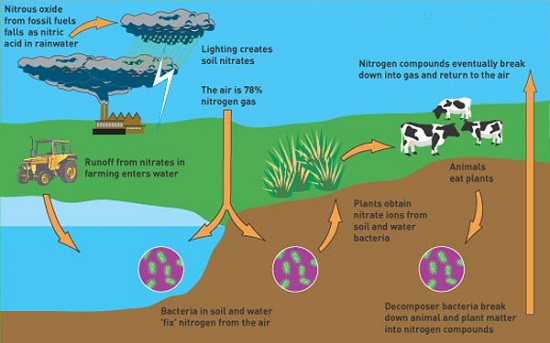Medicinal use of Microorganisms:

Microorganisms are used on a large scale in the medicinal sector. Several medicines make use of microbes in one way or the other. Some of them are listed below:
- Doctors prescribe us antibiotics, injections or capsules such as penicillin, all these are made of microorganisms.
- Bacteria and fungi are used nowadays to prepare medicines which fight against various disease-causing germs. Such medicines are called antibiotics.
- Streptomycin, erythromycin, tetracycline, amoxicillin, cefotaxime, cefoperazone etc. are made from bacteria and fungi and are some antibiotics.
- Microorganisms are also used to cure diseases in plants.
Vaccine:

- One of the main quality of human body is that it has tendency to fight against diseases.
- A small amount of disease-causing weak microbes (mainly they are dead) is inserted in our body, this makes the antibodies present in our body to fight against the particular microbe.
- Once the antibodies are activated it remembers how to fight with that particular microbe throughout life.
- This is the way how vaccine
- Cholera, TB, hepatitis, smallpox, hepatitis etc. are some diseases which can be prevented by vaccination.
Soil fertility:
- Blue-green algae are the most favourable microorganism which helps in increasing soil fertility.
- They help in nitrogen fixation.
- Leguminous plants contain rhizobium bacteria in its root nodule for nitrogen fixation.
- Plants utilize nitrogen from soil through their roots.
In the cleaning environment:
- Decomposers are the microorganisms which help in converting dead and decaying matters into simpler substances.
- Microbes have the main role in clearing organic waste from our surroundings.
Harmful microorganisms

- Many microbes cause several diseases in plants, animals & human beings.
- That is why we read this chapter as microorganism friend and foe.
- We call such disease-causing organisms as Pathogens.
- Bacteria, viruses, protozoa & fungi are pathogens.
- Typhoid is an example of diseases which is caused pathogen bacteria named as Salmonella typhi. This microorganism enters our body through contaminated food and water.
- Food, clothing, leather and many of our useful items get spoiled by microorganisms.
- Microbial diseases that can spread from an infected person to a healthy person through air, water, food or physical contact are called Communicable diseases.
Food poisoning
- Microbes produce toxic substances in the food and thus it gets poisoned.
- Eating such food makes us ill.
- Microbes do not attack a particular food, only it searches a suitable environment to survive.
- Moisture and warm temperature make it easy to survive thus releases toxic substance in food. Thus food poisoning occurs.
Food preservation

- Prevention of food from getting it spoiled by the action of microorganisms by taking suitable measures are said to be food preservation.
- It is very important to preserve food items so that microbes cannot grow & spoil them.
Methods of food preservation:
There are many methods of food preservation. We will discuss each one by one.
Chemical Methods of food preservation:
- Preservatives are the chemicals which check the growth of microorganisms on the food.
- In pickles, we use salt as preservatives.
- Also, salt is used to preserve meat and fish.
- Sugar is used in jams as a preservative material.
- Vinegar is used as preservative in vegetables.
- Sodium benzoate, oils (edible) and salts are common preservatives.
Heat and cold treatments
- We boil milk to kill microorganisms present in it.
- Milk for commercial use is pasteurized.
- The technique to boil milk at 70⁰C for 15 to 30 sec then suddenly cooled and stored is said to be pasteurization.
- We use refrigerators to preserve fruits, vegetables and edible items.
Proper storage and packing:
- Properly sealed packets or airtight containers are necessary to store some kind of food such as dry fruits.
- Such containers would inhibit the growth of microbes as they need moisture, air etc. for growth.
Nitrogen fixation
- The process of converting Nitrogen (N2) in the atmosphere into ammonia (NH3) inside the soil is said to be nitrogen fixation.
- Those bacteria which is involved in such process is said to be nitrogen-fixing bacteria.
- Rhizobium bacteria which lives in the root nodules of leguminous plants (peas and beans) helps in nitrogen fixation.
- Nitrogen also gets fixed through the action of lightning.
- However the atmospheric nitrogen is fixed, it neither decreases nor increases.
Nitrogen cycle
- Our atmosphere contains 78% nitrogen gas and is most essential for living organisms.
- Nitrogen is one of the main constituents of protein, chlorophyll and vitamins.
- Atmospheric nitrogen can’t be utilized directly by living beings.
- Blue-green algae and certain bacteria present in soil fix the nitrogen of atmosphere.
- Nitrogen gets utilised by plants from the soil through their root system then used for the synthesis of plant proteins and other important compounds.
- Heterotrophic animal feeds on plants and get protein and essential nutrients based on nitrogen.
- When plants and animals die, bacteria and fungi present in the soil convert the nitrogenous wastes into nitrogenous compounds.
- Plants use these nitrogenous compounds again.

We will have a detailed study of each topic in higher sections. However, the necessary material is provided in class 8 chapter 2 microorganism friend and foe notes.